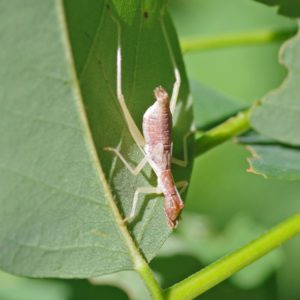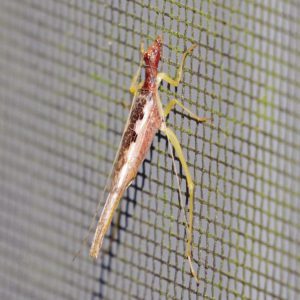Greetings BugFans,
The BugLady had a visitor at her front door the other day – a Two-spotted tree cricket. When they think of tree crickets, most people picture a delicate, flat, green member of the genus Oecanthus (https://bugguide.net/node/view/883267/bgpage). Oecanthus tree crickets, with a brief nod to the Two-spotted tree cricket, were celebrated in a previous BOTW https://uwm.edu/field-station/tree-crickets/. Today’s story is about that other tree cricket.
The Two-spotted tree cricket (Neoxabea bipunctata) (family Gryllidae) used to be grouped with the Oecanthus but was reclassified into the Neoxabea. According to bugguide.net, Neoxabea means “new tree cricket” – Xabea being yet another tree cricket genus and the one that the TSTC was assigned to before it was an Oecanthus. Neoxabea are called the “smooth-legged tree crickets” because the Oecanthus have spines on their hind legs and Neoxabea don’t. There are about a dozen species in the genus Neoxabea worldwide, but the TSTC is the only species north of the Rio Grande unless you count the Brownsville tree cricket (N. formosa), which barely makes it over the border and whose classification is a bit problematic. Here’s a glamour shot – https://bugguide.net/node/view/1475840/bgimage.

There was a reference to a common name for the TSTC in Ohio – “itch bug” – that the BugLady couldn’t find anything more about. Tree crickets, though they are (barely) capable of biting human skin, rarely do (in the BugLady’s experience, they’re too busy exiting the scene).
TSTCs, as one reference pointed out, are found over the eastern half of the country in approximately the same footprint as the original, eastern deciduous forests. They are associated with oak, apple, maple, white pine, and a variety of other trees, and also with wild grape and sunflower. They aren’t seen as often as their Oecanthus cousins because they tend to live higher off the ground in dense vegetation, and males sing from the undersides of leaves.
The cut of their jib is distinctly different from the other tree crickets. Unlike the Oecanthus https://bugguide.net/node/view/37247/bgimage, they tend to be pinkish, and the male’s wings are less flared https://bugguide.net/node/view/1611999/bgimage. Females have two dorsal spots; males don’t.
TSTCs have gradual metamorphosis – nymphs resemble the adults and there’s no resting/changing/pupal stage. Both adults and nymphs feed at dusk and by night on the same diet of tiny insects, bits of leaves, pollen, and fungi (and the BugLady wonders if maybe the one on the screen was grazing on the algae that grows there). They are preyed upon by wasps, including grass-carrying wasps, of previous BOTW fame, which collect them to cache for their young.
The male’s song is described as a broken trill (one source described it more authoritatively as “A plaintive, dissonant, buzzy trill at about 3.5 kHz, with a distinctive “screaming” quality.”). He produces sound by rubbing together the ridges on each wing (a “scraper” and “file”). In the spirit of cold-bloodedness, the warmer the air is, the more trills he generates, and he hedges his bets by chewing a hole in a leaf and positioning his wings and body over it so that the leaf acts like a megaphone. The tympanum (hearing organs) on her front legs must be tuned to distinguish his species from others at whatever rate he’s singing. She prefers males that sing “bass,” because they’re probably bigger and therefore have more sperm.
In a paper called “The Mating of Tree Crickets,” David Funk explains that because the sound is amplified backwards from the male, females tend to approach from the rear. He says that “When a male senses the presence of an approaching female, he stops singing and turns around to touch her with his antennae. It is thought that by “tasting” her in this way, he is able to assure that she is a member of the same species and therefore an appropriate mate.”

Their reproductive strategy includes a practice called courtship feeding. There’s a groove on the top of his thorax, between his wings, and into it oozes a substance produced by the metanotal gland, a substance that is irresistible to the female (sometimes unpaired females approach and try to feed, too). When the female climbs on his back to reach it, she is positioned so that the male is able to insert a spermatophore into the appropriate opening. She clings to his back, feeding, as he hangs from the vegetation https://bugguide.net/node/view/1778045/bgimage.
As she feeds, the spermatophore empties into her oviduct, and when she’s finished with the metanotal fluid, she eats the also-nutritional, empty spermatophore, too. Says Eric Eaton in his bugeric blog, the female would undoubtedly eat it [sooner] if she did not have the more attractive metanotal secretion to lick instead.”
She punches her ovipositor deep into a small branch https://bugguide.net/node/view/238538, inserts an egg and, says Bentley B. Fulton in a 1915 Technical Bulletin for the New York Agricultural Experiment Station, “Just before depositing the egg, and while the ovipositor is embedded for its full length in the bark, the female forces out a drop of excrement, which by stretching out the tip of the abdomen, she fastens to the bark just below the hole. After withdrawing the ovipositor she moves back, picks up the drop with her mouth and places it over the opening. Several minutes are then spent packing it in and smoothing it out.” https://bugguide.net/node/view/259844. Fulton’s article includes some lovely, pre-digital illustrations https://orthsoc.org/sina/s576lf15.pdf.
The eggs hatch in spring and the nymphs are pretty cute – the butts-up position is a common pose https://bugguide.net/node/view/1834770/bgimage. Here’s an excellent set of pictures of ages and stages https://orthsoc.org/sina/601a.htm, plus sounds.
Sometimes the punctures she makes as she’s ovipositing damage woody plants by weakening the twigs, but it’s seldom a problem, and one Exterminator’s website included a link to “detailed information about this fascinating insect.”
Go outside. Listen!
Kate Redmond, The BugLady
